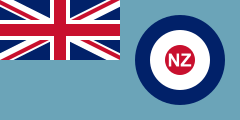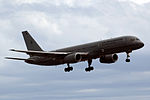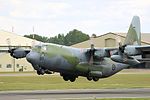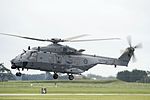Royal New Zealand Air Force
|
Royal New Zealand Air Force (RNZAF) |
|
|---|---|
 Flag of the RNZAF |
|
| Lineup | 1923 as part of the army founded April 1, 1937 independent armed forces |
| Country |
|
| Armed forces | New Zealand Defense Force |
| Type | Armed forces ( air force ) |
| Strength | 3253 (with civilian personnel and active reserve) |
| Bases |
Auckland |
| motto | " Per ardua ad astra " ( lat. "Through difficulties to the stars") |
| management | |
| Chief of Air Force | Air Vice Marshal Mike Yardley |
| Deputy Chief of Air Force | Air Commodore Andrew Woods |
| Air Component Commander | Air Commodore Kevin McEvoy |
| insignia | |
| Aircraft cockade |
 
|
The Royal New Zealand Air Force , the Air Force of New Zealand . The RNZAF was formed from units of the Royal Air Force , in 1923 it became an independent armed force.
The RNZAF fought in some wars, e.g. B. World War II , Malaysia, Vietnam War , Gulf War and various United Nations peacekeeping missions . Today the RNZAF fleet consists of around 50 aircraft. Since 2001, the RNZAF has had no military clout, since then it has been limited to sea patrols and transport tasks for the Army and Navy.
The motto of the RNZAF, like that of the RAF , is Per ardua ad astra - “Through difficulties to the stars”.
history
The history of military aviation in New Zealand begins in 1913 when the Royal New Zealand Army received a Bleriot monoplane from Great Britain . During the First World War , some pilots who were trained in flight schools in Auckland and Christchurch , among others, flew as part of the British Royal Flying Corps and the Royal Naval Air Service. In 1923 the New Zealand Permanent Air Force was formed as part of the army, comprising 72 pilots with experience from World War I. At first it was equipped with British-made double-deckers . In 1934 it was renamed the Royal New Zealand Air Force and in 1937 it became an independent part of the New Zealand Armed Forces.
Second World War
When the Second World War broke out , the RNZAF's equipment consisted mainly of Vickers Wellington bombers, which the New Zealand government also offered to the United Kingdom , along with crews who flew the bombers. Many other New Zealanders served in the RAF. The main task of the RNZAF was to take advantage of the distance to Europe in order to train crews under the Empire Air Training Scheme together with other British colonies and Dominions, e.g. B. Canada , Australia and South Africa . For this task many newer monoplane was procured or built in New Zealand. Also used biplanes like the Hawker Hind as well as airplanes that were no longer suitable for the front, e.g. B. the Avro Anson were used.
Squadrons from New Zealand in the RAF
Most of the crews from New Zealand served together in normal squadrons with the RAF or with the Fleet Air Arm . Among the New Zealanders in the RAF were pilots like the First Allied Ace, Flying Officer Edgar James ('Cobber') Cain, and commanders like the Ace of World War I, Air Chief Marshal Sir Keith Park , who took the 11th Group in the air battle England commanded pilots who defended Malta from the air and flew in the RAF in Southeast Asia at the end of the war.
Some squadrons in the Royal Air Force deliberately consisted of pilots from one country only. The first of these squadrons was the 75th Squadron, which was formed from the Wellingtons and their pilots, which had been borrowed from New Zealand in August 1939. Later this season was equipped with Short Stirlings , Avro Lancasters and Avro Lincolnns . Later seasons from New Zealand were:
- 485th Squadron - Supermarine Spitfire
- 486th Squadron - Hawker Hurricane , Hawker Typhoon , Hawker Tempest
- 487th Squadron - Lockheed Ventura , De Havilland DH.98 Mosquito
- 488th Squadron - Brewster Buffalo , Hawker Hurricane , Bristol Beaufighter , De Havilland Mosquitos
- 489th Squadron - Bristol Blenheim , Bristol Beaufort , Handley Page Hampden , Bristol Beaufighter, De Havilland Mosquitos
- 490 Squadron - Consolidated Catalina , Short Sunderland
The RNZAF in the Pacific
In December 1941, Japan attacked the United States and quickly captured areas north of New Zealand. It was therefore imperative that New Zealand set up its own defense and not just help the “ mother country ”. Very few fighter jets were available in New Zealand and Britain was unable to help, so New Zealand (like Australia ) turned to the US and signed a loan and lease agreement . It was some time before the US could supply New Zealand with airplanes.
The aircraft that were initially received from the United States under the agreement were obsolete and unable to hold their own against the well-equipped and trained Japanese air force , but nothing else was available and the RNZAF fought in Guadalcanal , where the RNZAF was involved Curtiss Kittyhawks fought, excellent. Other squadrons flew the old but effective SBD Dauntless and later the modern Grumman TBF Avenger torpedo bomber. The RNZAF also did a major part of the maritime reconnaissance for the Allies, with Catalina (and later Sunderland) flying boats and Lockheed Hudson bombers.
As the war progressed, the RNZAF got more and more modern aircraft. The Kittyhawks were replaced by Corsairs and the Hudsons by Venturas. At its peak, the RNZAF had 13 squadrons in the Pacific with Corsairs, 6 with Venturas, 2 each with Catalinas and Avengers, a squadron of Dauntless dive bombers and transport aircraft to support. The RNZAF had over 41,000 employees worldwide.
Cold War
After the Second World War, 14 squadrons were sent to Japan as part of the occupying forces. The rest of the Air Force quickly got rid of the aircraft and crews and began a training and transport mode before the 14th and 75th Squadrons were re-formed. The 42nd Squadron was set up as an internal communications and transport squadron and still exists today. The first Gloster Meteor arrived in 1946, marking the start of the jet age.
With the Bell 47 , the helicopter age began in the RNZAF, and the RNZAF's Bell UH-1 Iroquois were sent to Sinai and East Timor , while the Westland Wasp and the Kaman SH-2 Seasprite were only nominally in the RNZAF.
The RNZAF took part in the Vietnam War and mainly uses transport aircraft to support the ground troops.
The RNZAF after the Cold War
After the Cold War , the RZNAF was downsized, but modernized. She supported the USA in the war in Afghanistan , in the Gulf War and in various UN missions.
In 2001 the Labor government, which preferred a milder security policy, stopped the procurement of 28 F-16 Fighting Falcon and put the Douglas A-4 and the Aermacchi MB 339 out of service. One of the squadrons that was retired was the famous No. 75 Squadron, a former New Zealand squadron in the RAF .
In 2003 the RNZAF was reduced to 50 aircraft and 2,523 personnel. The RNZAF currently no longer has any military clout. Your duties consist of a sea patrol, search and rescue (SAR) and transport.
2005 chose Ministry of Defense of New Zealand , the NH90 to the already aged 14 Bell UH-1 Iroquois of RNZAF replace. The procurement will cost NZ $ 550 million.
organization
Flying squadrons:
- Operational Squadrons
- No.3 Squadron
- No.5 Squadron
- No.6 Squadron
- No.40 Squadron
- Training squadrons
- No.14 Squadron
- No.42 Squadron
Main bases:
Current equipment
The Royal New Zealand Air Force operates 26 aircraft and 22 helicopters (as of the end of 2019).
| Aircraft | image | origin | use | version | active | Ordered | Remarks |
|---|---|---|---|---|---|---|---|
| Planes | |||||||
| Lockheed P-3 Orion |

|
|
Maritime patrol aircraft | P-3K / K2 | 6th | Target by the P-8 Poseidon be replaced | |
| Boeing P-8 Poseidon |

|
|
Maritime patrol aircraft | 4th | Replaces the P-3 Orion | ||
| Boeing 757 |

|
|
Transport plane | 757-200 | 2 | ||
| Lockheed C-130 Hercules |

|
|
Military transporter | C-130H C-130J-30 |
5 |
5 |
The C-130H from the 1960s are to be replaced by the new C-130J. |
| Beechcraft King Air |

|
|
Trainer aircraft | King Air 350 | 3 | ||
| Beechcraft T-6 Texan II |

|
|
Trainer aircraft | T-6C | 10 | ||
| helicopter | |||||||
| Kaman SH-2 Seasprite |
|
|
Board helicopter | SH-2G (I) Super Seasprite | 9 | ||
| Agusta A109 |

|
|
Light multipurpose helicopter | A109 LUH | 5 | ||
| NHIndustries NH90 |

|
|
Multipurpose tactical helicopter | NH90 TTH | 8th | Plus a machine as a spare parts dispenser | |
Symbols, flags and badges

The RNZAF flag was introduced in 1939 , based on the flag of the RAF , with the letters "NZ" placed in the roundel.
Until the 1950s, the RNZAF aircraft flew with the RAF roundabout , identified only by the prefix “NZ” in front of the serial number to indicate nationality within the Commonwealth. A white kiwi, a silver fern or the New Zealand flag sometimes appeared on RNZAF aircraft, but also on RAF aircraft that were flown by New Zealand pilots. The outline of New Zealand with a kiwi was seen on the Canberras flying in Malaysia on a peacekeeping mission.
From the mid-1950s there was an RNZAF Rondell (cockade) with a silver fern in the inner red circle. The kiwi was introduced in the 1960s. To improve camouflage, the white circle was sometimes left out. The kiwi rondel is now sometimes a black circle around a black kiwi or in a two-tone gray.
See also
Web links
- Air Force . New Zealand Defense Force,accessed May 4, 2018.
Individual evidence
- ↑ World Air Force 2020. Flight International , December 10, 2019, accessed June 9, 2020 .
- ↑ Nick Perry: New Zealand military buys 5 Lockheed Hercules planes for $ 1 billion. In: defensenews.com. Associated Press , June 6, 2020, accessed June 9, 2020 .
